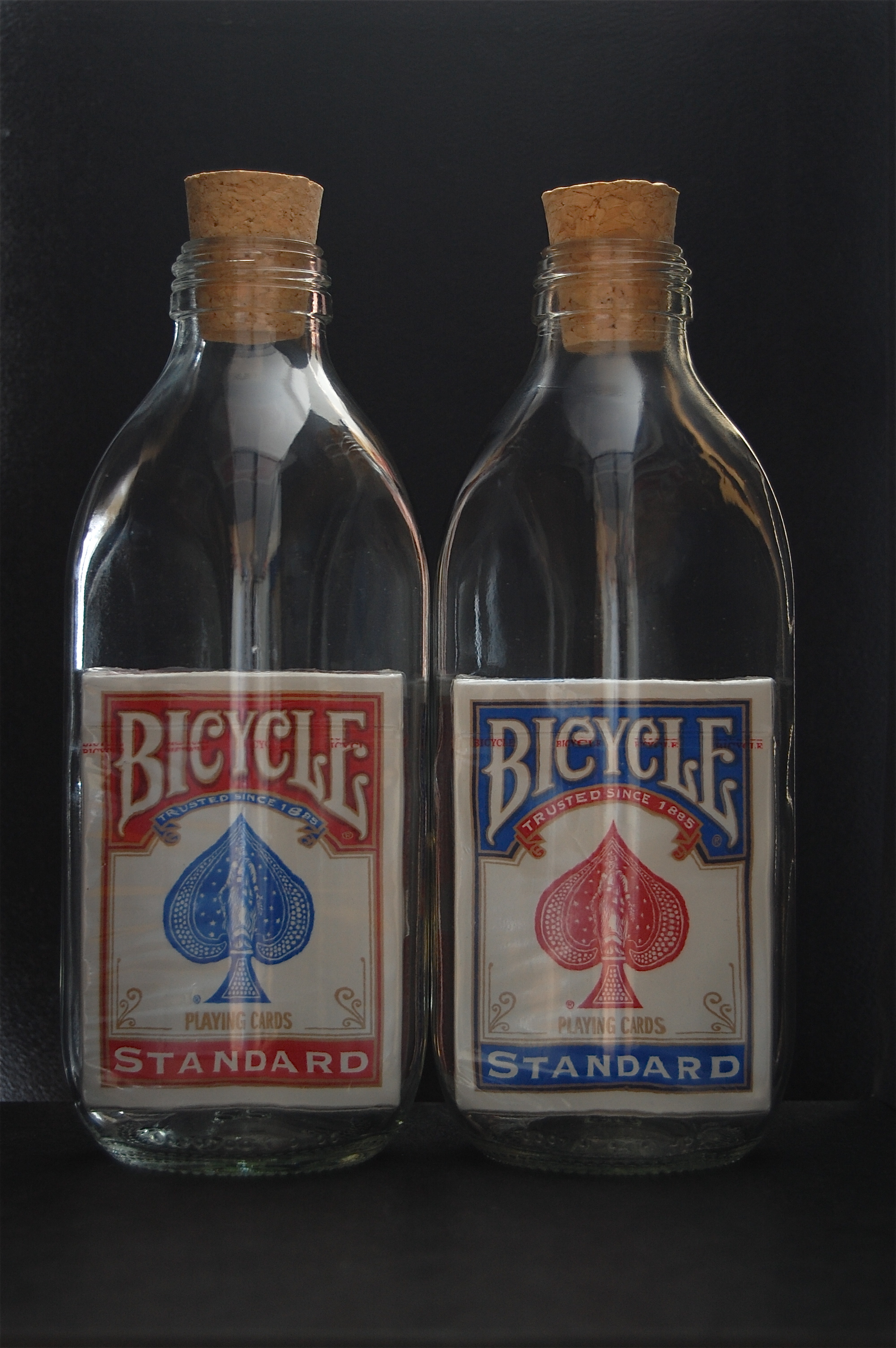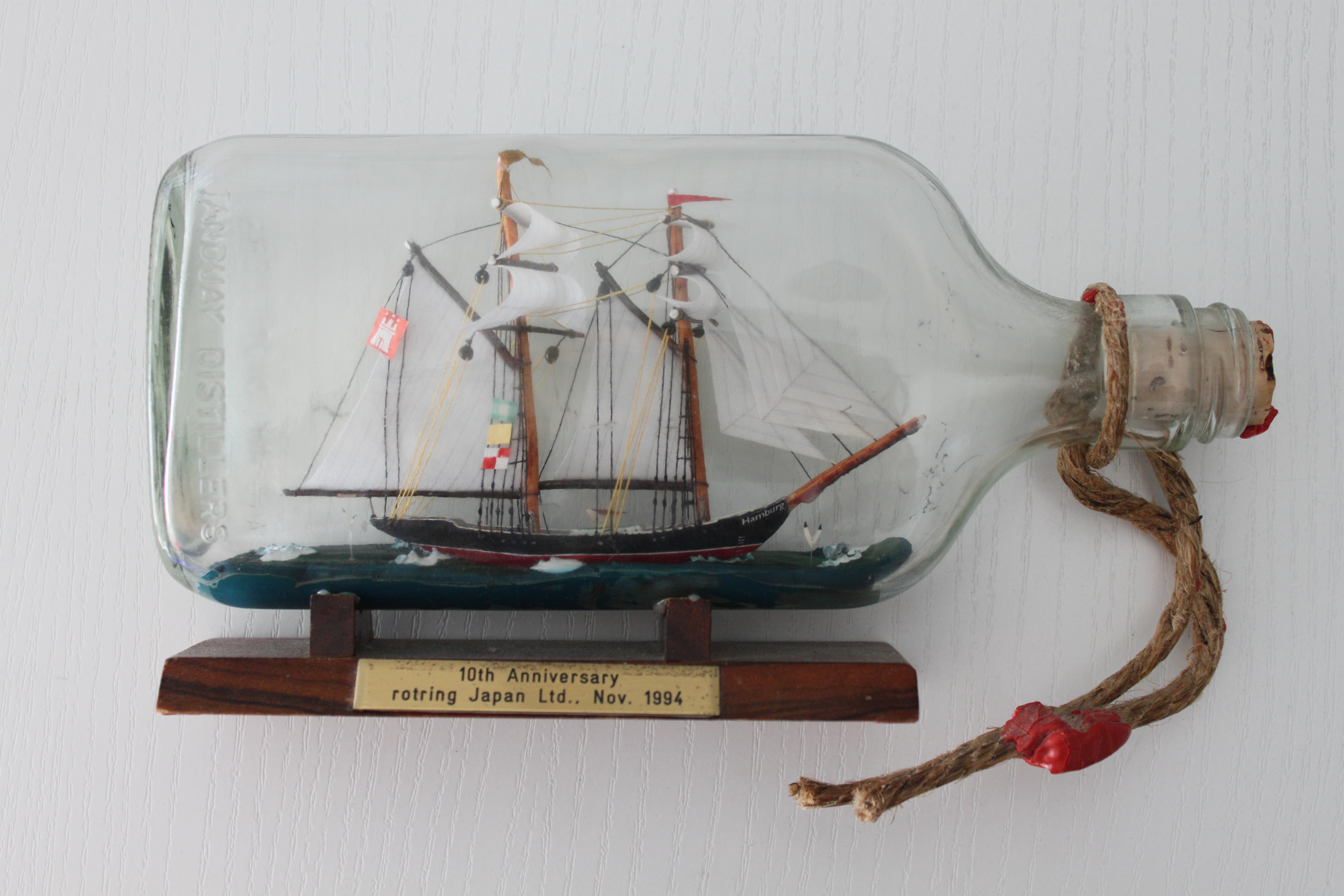Ship In A Bottle on:
[Wikipedia]
[Google]
[Amazon]
 An impossible bottle is a bottle containing an object that does not appear to fit through the bottle's mouth.
The
An impossible bottle is a bottle containing an object that does not appear to fit through the bottle's mouth.
The
 There are two ways to place a model ship inside a bottle. The simpler way is to rig the masts of the ship and raise it up when the ship is inside the bottle. Masts, spars, and sails are built separately and then attached to the hull of the ship with strings and hinges so the masts can lie flat against the deck. The ship is then placed inside the bottle and the masts are pulled up using the strings attached to the masts. The hull of the ship must still be able to fit through the opening. Bottles with minor distortions and soft tints are often chosen to hide the small details of the ship such as hinges on the masts. Alternatively, with specialized long-handled tools, it is possible to build the entire ship inside the bottle.
The oldest surviving ships in a bottle were crafted by Giovanni Biondo at the end of the eighteenth century; two, at least, reproduce Venetian ships of the line. These are quite large and expensive models: the bottles (intended to be displayed upside down, with the neck resting on a small pedestal) measure about 45 cm. The oldest (1784) is in a museum in Lübeck; another (1786) is held by a private collector; the third (1792), that apparently reproduces the
There are two ways to place a model ship inside a bottle. The simpler way is to rig the masts of the ship and raise it up when the ship is inside the bottle. Masts, spars, and sails are built separately and then attached to the hull of the ship with strings and hinges so the masts can lie flat against the deck. The ship is then placed inside the bottle and the masts are pulled up using the strings attached to the masts. The hull of the ship must still be able to fit through the opening. Bottles with minor distortions and soft tints are often chosen to hide the small details of the ship such as hinges on the masts. Alternatively, with specialized long-handled tools, it is possible to build the entire ship inside the bottle.
The oldest surviving ships in a bottle were crafted by Giovanni Biondo at the end of the eighteenth century; two, at least, reproduce Venetian ships of the line. These are quite large and expensive models: the bottles (intended to be displayed upside down, with the neck resting on a small pedestal) measure about 45 cm. The oldest (1784) is in a museum in Lübeck; another (1786) is held by a private collector; the third (1792), that apparently reproduces the
Folk Art in Bottles
{{DEFAULTSORT:Impossible Bottle Bottles Mechanical puzzles
 An impossible bottle is a bottle containing an object that does not appear to fit through the bottle's mouth.
The
An impossible bottle is a bottle containing an object that does not appear to fit through the bottle's mouth.
The ship
A ship is a large watercraft that travels the world's oceans and other sufficiently deep waterways, carrying cargo or passengers, or in support of specialized missions, such as defense, research, and fishing. Ships are generally distinguished ...
in a bottle is a traditional and the most iconic type of impossible bottle. Other common objects include fruits, matchbox
Phillumeny (also known as phillumenism) is the hobby of collecting different match-related items: matchboxes, matchbox labels, matchbooks, matchcovers, matchsafes, etc.
Matchbox
A matchbox is a box made of cardboard or thin wood and designe ...
es, decks of cards, tennis ball
A tennis ball is a ball designed for the sport of tennis. Tennis balls are fluorescent yellow in organised competitions, but in recreational play can be virtually any color. Tennis balls are covered in a fibrous felt which modifies their aerodyna ...
s, racketball
Racquetball is a racquet sport and a team sport played with a hollow rubber ball on an indoor or outdoor court. Joseph Sobek invented the modern sport of racquetball in 1950, adding a stringed racquet to paddleball in order to increase velo ...
s, Rubik's Cubes, padlock
Padlocks are portable locks with a shackle that may be passed through an opening (such as a chain link, or hasp staple) to prevent use, theft, vandalism or harm.
Naming and etymology
The term '' padlock'' is from the late fifteenth century. ...
s, knot
A knot is an intentional complication in cordage which may be practical or decorative, or both. Practical knots are classified by function, including hitches, bends, loop knots, and splices: a ''hitch'' fastens a rope to another object; a ' ...
s, and scissors. These may be placed inside the bottle using various mechanisms, including constructing an object inside the bottle from smaller parts, using a small object that expands or grows inside the bottle, or molding the glass around the object.
Ship in a bottle
heavy frigate
A frigate () is a type of warship. In different eras, the roles and capabilities of ships classified as frigates have varied somewhat.
The name frigate in the 17th to early 18th centuries was given to any full-rigged ship built for speed and ...
PN Fama, is in the Navy Museum in Lisbon. Another old model (1795), from an unknown builder, is kept in a museum in Rotterdam.
Ships in bottles became more popular as folk art in the second half of the nineteenth century, after the introduction of cheap, mass-produced bottles made with clear glass.
A significant collection of ships in bottles is the Dashwood-Howard collection held by the Merseyside Maritime Museum
The Merseyside Maritime Museum is a museum based in the city of Liverpool, Merseyside, England. It is part of National Museums Liverpool and an Anchor Point of ERIH, The European Route of Industrial Heritage. It opened for a trial season in 19 ...
.
Small objects that expand naturally
One variation of the impossible bottle takes advantage ofpine cone
A conifer cone (in formal botanical usage: strobilus, plural strobili) is a seed-bearing organ on gymnosperm plants. It is usually woody, ovoid to globular, including scales and bracts arranged around a central axis, especially in conifers an ...
s opening as they dry out. In constructing the display, a closed, green cone of suitable size is inserted into a narrow-mouthed bottle and then allowed to dry inside the bottle.
Fruits and vegetables inside bottles are grown by placing a bottle around the blossom or young fruit and securing it to the plant. The fruit then grows to full size inside the bottle. This technique is used to put pears into bottles of pear brandy (most famously the French eau de vie
An ''eau de vie'' (French for spirit, §16, §17 literally " water of life") is a clear, colourless fruit brandy that is produced by means of fermentation and double distillation. The fruit flavor is typically very light.
In English-speakin ...
Poire Williams
Poire Williams is the name for eau de vie
An ''eau de vie'' (French for spirit, §16, §17 literally " water of life") is a clear, colourless fruit brandy that is produced by means of fermentation and double distillation. The fruit flavor ...
).
Penny in a bottle
A US one-cent coin sealed inside a small bottle is a common souvenir. They are mass-produced usingglassblowing
Glassblowing is a glassforming technique that involves inflating molten glass into a bubble (or parison) with the aid of a blowpipe (or blow tube). A person who blows glass is called a ''glassblower'', ''glassmith'', or ''gaffer''. A '' lampworke ...
techniques, by placing a coin inside a semi-molten glass cup, and then reshaping the open end into a narrow neck and mouth, completing the bottle. Non-metallic objects need to be protected from the hot glass to prevent scorching, for example with a fireproof cloth.
See also
*Bonsai Kitten
Bonsai Kitten was a hoax website that claimed to instruct readers how to raise a kitten in a jar, so as to mold the bones of the kitten into the shape of the jar as the cat grows in the same way as a bonsai plant. It was made by an MIT student go ...
* Chinese puzzle ball
A Chinese puzzle ball, sometimes known as a devil's work ball ( zh, s=鬼工球, p=guǐ gōng qiú), is a Chinese-made artifact that consists of a number of intricately carved concentric hollow spheres carved from a single solid block that fit wi ...
References
External links
Folk Art in Bottles
{{DEFAULTSORT:Impossible Bottle Bottles Mechanical puzzles